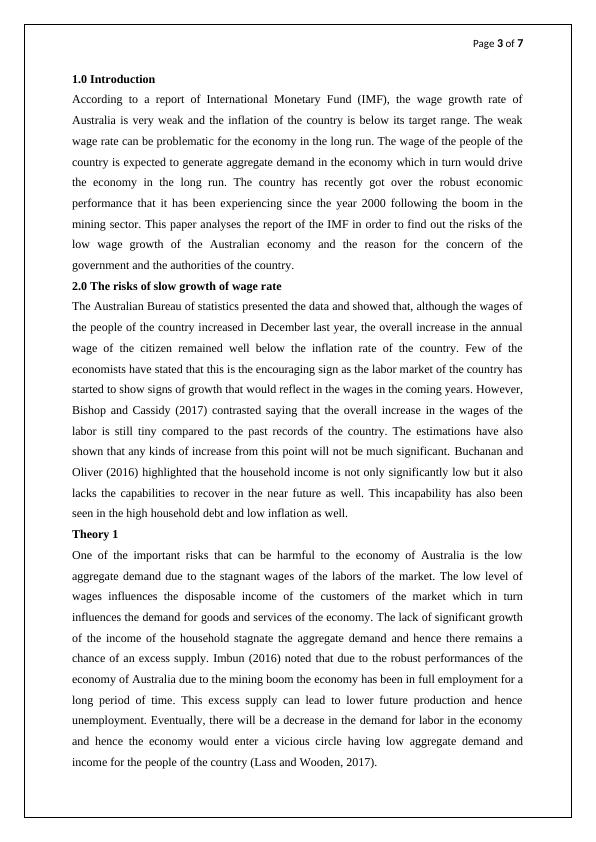The risks of slow growth of wage rate
Added on 2021-04-17
7 Pages2013 Words89 Views
Page 1 of 7ASSESSMENT TASK 2INDIVIDUAL ESSAYMACRO ECONOMICS

Page 2 of 7Table of contents1.0 Introduction..........................................................................................................................32.0 The risks of slow growth of wage rate.................................................................................33.0 Why government wants to see a general rise in wage rate..................................................44.0 Conclusion:..........................................................................................................................5Reference....................................................................................................................................7

Page 3 of 71.0 IntroductionAccording to a report of International Monetary Fund (IMF), the wage growth rate ofAustralia is very weak and the inflation of the country is below its target range. The weakwage rate can be problematic for the economy in the long run. The wage of the people of thecountry is expected to generate aggregate demand in the economy which in turn would drivethe economy in the long run. The country has recently got over the robust economicperformance that it has been experiencing since the year 2000 following the boom in themining sector. This paper analyses the report of the IMF in order to find out the risks of thelow wage growth of the Australian economy and the reason for the concern of thegovernment and the authorities of the country. 2.0 The risks of slow growth of wage rateThe Australian Bureau of statistics presented the data and showed that, although the wages ofthe people of the country increased in December last year, the overall increase in the annualwage of the citizen remained well below the inflation rate of the country. Few of theeconomists have stated that this is the encouraging sign as the labor market of the country hasstarted to show signs of growth that would reflect in the wages in the coming years. However,Bishop and Cassidy (2017) contrasted saying that the overall increase in the wages of thelabor is still tiny compared to the past records of the country. The estimations have alsoshown that any kinds of increase from this point will not be much significant. Buchanan andOliver (2016) highlighted that the household income is not only significantly low but it alsolacks the capabilities to recover in the near future as well. This incapability has also beenseen in the high household debt and low inflation as well. Theory 1One of the important risks that can be harmful to the economy of Australia is the lowaggregate demand due to the stagnant wages of the labors of the market. The low level ofwages influences the disposable income of the customers of the market which in turninfluences the demand for goods and services of the economy. The lack of significant growthof the income of the household stagnate the aggregate demand and hence there remains achance of an excess supply. Imbun (2016) noted that due to the robust performances of theeconomy of Australia due to the mining boom the economy has been in full employment for along period of time. This excess supply can lead to lower future production and henceunemployment. Eventually, there will be a decrease in the demand for labor in the economyand hence the economy would enter a vicious circle having low aggregate demand andincome for the people of the country (Lass and Wooden, 2017).

End of preview
Want to access all the pages? Upload your documents or become a member.
Related Documents
Economic Policy Frameworks and Markets - PDFlg...
|13
|2327
|237
Economics Policy Framework and Marketlg...
|15
|2105
|20
Impact of Low Wages on Economic Growth in Australialg...
|7
|1961
|78
Analysis of Low Real Wage Growth in Australialg...
|7
|1024
|105
Macroeconomic Analysis Assignmentlg...
|9
|2055
|28
Factors Explaining Slow Economic Growth in Australialg...
|7
|514
|50
